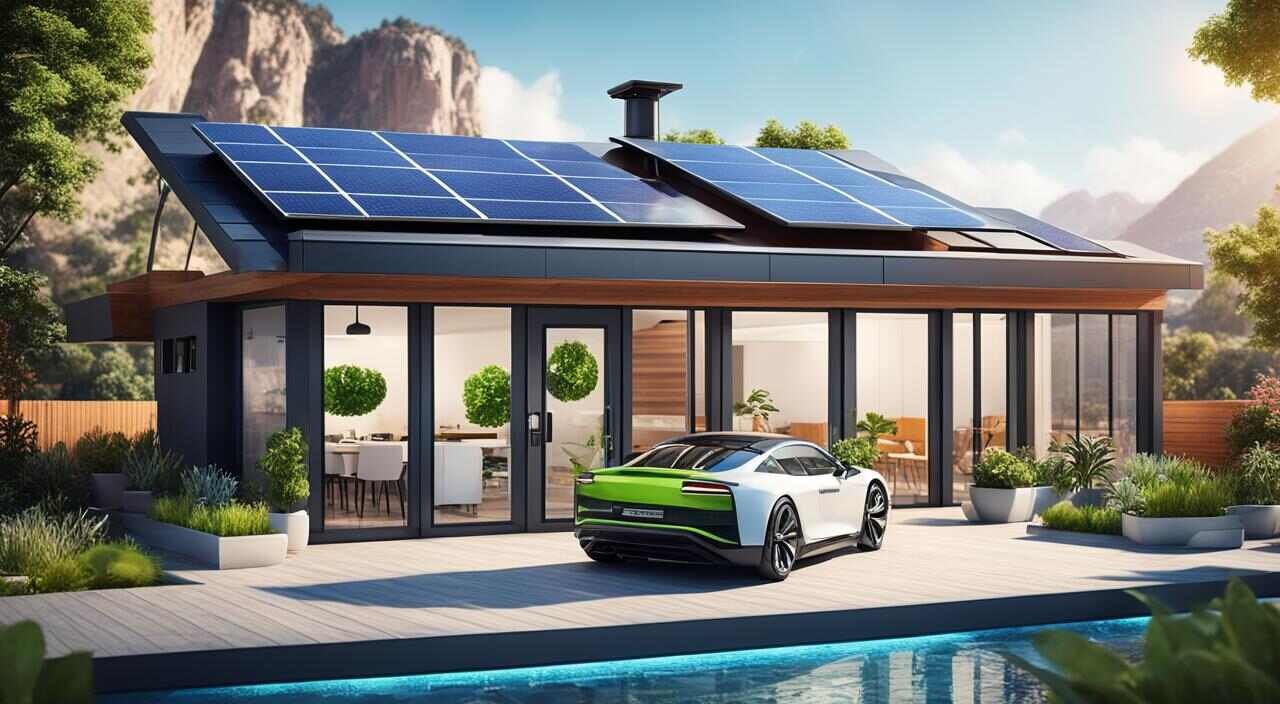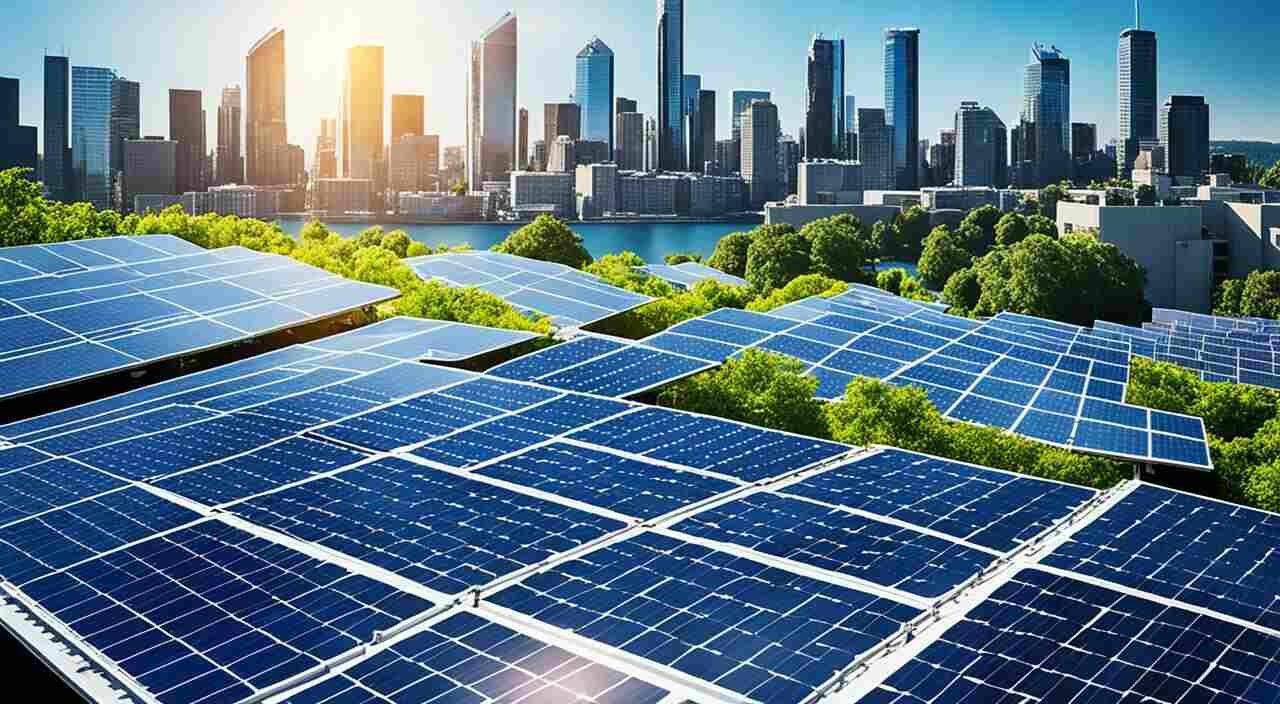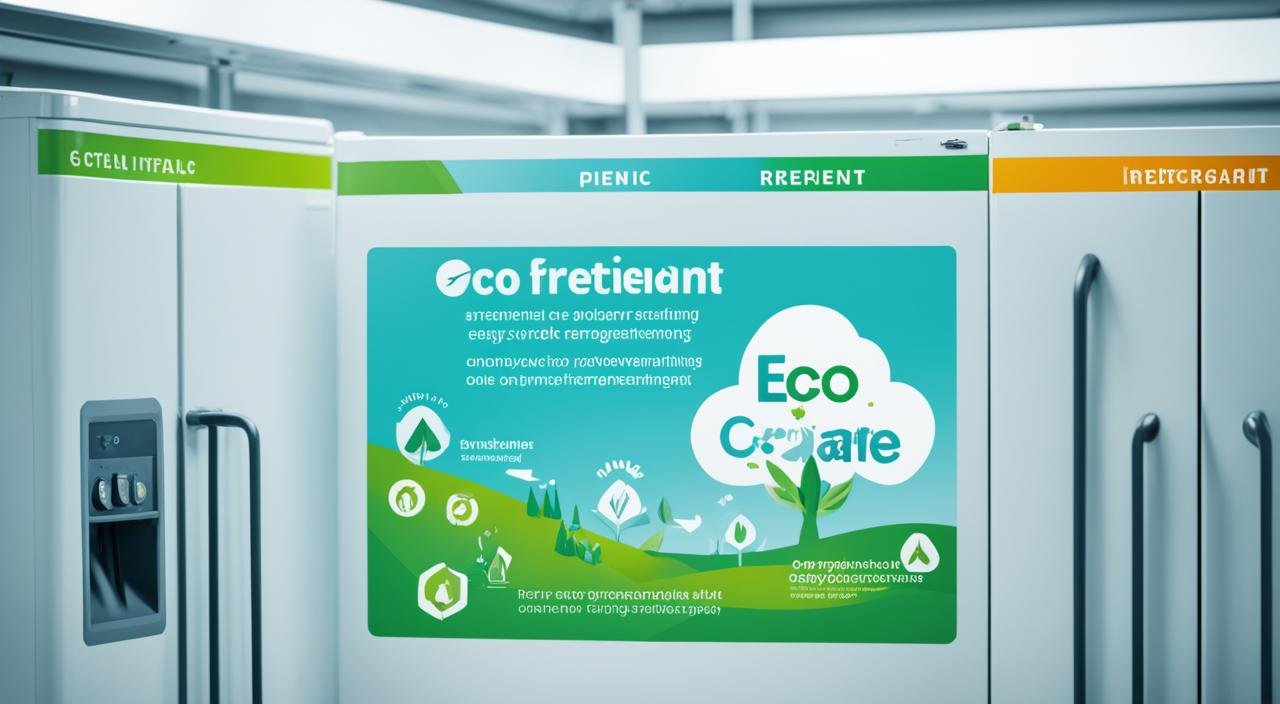The concept of sustainable living has never been more important than it is today. As individuals, we have a responsibility to reduce our environmental impact and embrace eco-friendly solutions. This includes making conscious choices when it comes to our homes. Green home innovations, sustainable home technology, and eco-friendly solutions are key trends that are shaping the way we live.
Key Takeaways:
- Embracing sustainable home technology and innovations is crucial for a greener future.
- Energy-efficient appliances can significantly reduce electricity consumption and lower utility bills.
- Renewable energy systems, such as solar panels and wind energy, offer sustainable alternatives to traditional energy sources.
- Using sustainable building materials like bamboo and reclaimed wood helps reduce environmental impact.
- Sustainable home design principles, such as passive design and energy-efficient windows, promote energy efficiency.
Improving Energy Efficiency with Eco-Friendly Appliances
One of the key aspects of green home innovations is improving energy efficiency. By incorporating energy-efficient appliances into your home, you can significantly reduce your electricity consumption and lower utility bills. These appliances are designed to operate with optimal energy usage, helping you save money while minimizing your environmental impact.
When choosing energy-efficient appliances, look for the Energy Star label. Energy Star is a government-backed program that identifies products that meet strict energy efficiency guidelines. Appliances with the Energy Star label consume less energy than standard models, resulting in lower utility bills and reduced carbon emissions.
| Benefits of Energy-Efficient Appliances | How Energy-Efficient Appliances Lower Utility Bills |
|---|---|
| Lower energy consumptionReduced carbon emissionsLong-term cost savingsEnhanced durability and performance | Use less electricityRequire less frequent repairsMinimize energy wastePotential rebates and incentives |
By investing in energy-efficient appliances, you can enjoy the benefits of lower utility bills and contribute to a greener future. These appliances not only help you save money in the long run but also reduce your carbon footprint and promote energy conservation.
Quote:
“Energy-efficient appliances are a win-win solution for homeowners looking to reduce their environmental impact and save money on utility bills.” – Jane Smith, Green Living Expert
Incorporating Renewable Energy Systems for Sustainable Living
As the world strives towards a more sustainable future, the integration of renewable energy systems has emerged as a pivotal trend in green home innovations. Homeowners today are increasingly opting for solar panels and wind energy solutions to power their homes and reduce their carbon footprint.
Solar panels are a popular choice for homeowners looking to harness the power of the sun to generate electricity. These photovoltaic systems convert sunlight into usable energy, allowing homeowners to significantly reduce their dependence on non-renewable energy sources. By making the switch to solar panels, you can not only save on your electricity bills but also contribute to a cleaner and greener environment.
For areas with consistent wind patterns, wind energy can also be a viable option. Wind turbines can convert the kinetic energy of the wind into electricity, providing a sustainable source of power for your home. Incorporating wind energy systems allows you to tap into a renewable resource and further reduce your reliance on fossil fuels.
Benefits of Incorporating Renewable Energy Systems
Integrating renewable energy systems into your home design offers a range of benefits:
- Lower energy costs: By generating your own electricity, you can reduce or eliminate your reliance on traditional power sources, resulting in lower utility bills.
- Reduced carbon footprint: Renewable energy systems produce clean energy, significantly reducing greenhouse gas emissions and combating climate change.
- Energy independence: By harnessing the power of the sun or wind, you become less reliant on external energy providers, giving you more control over your energy consumption.
- Long-term savings: While the initial installation costs may be higher, renewable energy systems offer long-term savings through reduced energy bills and potential government incentives.
The Role of Sustainable Home Design
When incorporating renewable energy systems into your home, it is essential to consider sustainable home design principles. By optimizing your home’s orientation, insulation, and ventilation, you can maximize the efficiency of your renewable energy systems.
Table: Comparison of Renewable Energy Systems
| Renewable Energy System | Advantages | Considerations |
|---|---|---|
| Solar panels | – Utilizes abundant sunlight – Can generate electricity even on cloudy days | – Initial installation costs – Requires proper orientation and adequate roof space |
| Wind energy | – Can generate significant amounts of electricity – Suitable for windy areas | – Noise concerns – Appropriate zoning regulations |
“Integrating renewable energy systems into your home not only benefits the environment but also offers long-term savings and energy independence.” – John Green, Sustainable Home Designer
By incorporating renewable energy systems, such as solar panels and wind energy, into your home, you can contribute to a more sustainable lifestyle and reduce your impact on the environment. These innovative solutions provide both economic and environmental benefits, making them a worthwhile investment for homeowners committed to embracing sustainable living.
Sustainable Building Materials for Green Home Design
When it comes to designing eco-friendly homes, the choice of building materials is crucial. By opting for sustainable construction materials, homeowners can significantly reduce their environmental impact while creating beautiful and functional spaces. Green building materials offer a range of benefits, including lower carbon emissions, improved energy efficiency, and the conservation of natural resources.
There are several sustainable building materials that are gaining popularity in green home design:
- Bamboo: Bamboo is a highly renewable material known for its strength and durability. It grows quickly and requires minimal resources, making it an excellent alternative to traditional timber. Bamboo can be used for various applications, including flooring, furniture, and even structural elements.
- Reclaimed Wood: Reclaimed wood is sourced from old buildings or structures and repurposed for new construction projects. By using reclaimed wood, homeowners can minimize the demand for new timber logging and contribute to the preservation of forests. Reclaimed wood adds a unique character and warmth to any home.
- Cork: Cork is an eco-friendly material made from the bark of cork oak trees. Harvesting the bark does not harm the trees, allowing them to regenerate and continue absorbing carbon dioxide. Cork is an excellent choice for flooring, as it is comfortable, durable, and provides natural thermal and acoustic insulation.
- Recycled Glass: Using recycled glass in home construction helps reduce waste and conserves energy. Glass tiles and countertops made from recycled glass not only add a stylish and contemporary touch to a home but also contribute to sustainable practices. Recycled glass can also be used for insulation and as an eco-friendly alternative to traditional aggregates in concrete.
- Natural Clay: Clay is a versatile and environmentally friendly material that has been used for centuries in construction. It is abundant, non-toxic, and recyclable. Clay can be used for wall finishes, flooring, and even structural elements. Its natural thermal properties help regulate indoor temperature and create a comfortable living environment.
By incorporating these sustainable building materials into green home design, homeowners can create spaces that are not only visually appealing but also environmentally responsible. These materials offer durability, energy efficiency, and a reduced carbon footprint, making them the ideal choice for eco-friendly homes.
Sustainable Building Materials Comparison
| Building Material | Renewability | Durability | Energy Efficiency | Carbon Footprint |
|---|---|---|---|---|
| Bamboo | Highly renewable | Durable | Excellent insulation properties | Low carbon emissions |
| Reclaimed Wood | Reuse of existing material | Durable if properly maintained | Provides some insulation | Reduces demand for new timber |
| Cork | Renewable bark harvesting | Durable and resilient | Natural thermal and acoustic insulation | Low energy production process |
| Recycled Glass | Reuse of waste material | Durable and resistant to stains | Does not require additional energy for production | Reduces landfill waste |
| Natural Clay | Abundant and recyclable | Durable and fire-resistant | Natural thermal regulation | Low energy production process |
Embracing Sustainable Design Principles for Energy Efficiency
In order to create energy-efficient homes, it is essential to embrace sustainable design principles. By incorporating passive design strategies, energy-efficient windows, and maximizing natural lighting, you can significantly reduce energy consumption and create a more sustainable living environment.
Passive Design
Passive design strategies are a cornerstone of energy-efficient home design. By utilizing techniques such as thermal mass walls and strategically placed windows, you can regulate indoor temperature naturally, reducing the need for mechanical heating or cooling systems. This not only saves energy but also enhances comfort and reduces utility costs.
Energy-Efficient Windows
Energy-efficient windows play a vital role in creating an energy-efficient home. These windows are designed to minimize heat transfer, keeping your home cool in summer and warm in winter. They are often double or triple glazed, filled with insulating gases, and equipped with low-E coatings, reducing the reliance on heating and cooling systems.
Natural Lighting
Natural lighting is not only aesthetically pleasing but also contributes to energy efficiency. By maximizing the use of natural light through well-placed windows, skylights, and light wells, you can minimize the need for artificial lighting during the day. This reduces energy consumption and creates a healthier, more enjoyable living space.
When designing your home, consider the placement and size of windows to optimize natural light throughout the day. Combine natural lighting with efficient lighting fixtures, such as LED bulbs, to further enhance energy savings.
By incorporating passive design strategies, energy-efficient windows, and maximizing natural lighting, you can create an energy-efficient home that reduces environmental impact and promotes sustainable living.
Green Home Remodeling for a Sustainable Lifestyle
Green home remodeling is a growing trend among homeowners who are committed to creating a more sustainable and environmentally friendly living space. By incorporating energy-efficient upgrades, choosing eco-friendly materials, and utilizing energy-saving technologies, you can transform your home into a sustainable sanctuary.
One of the key aspects of green home remodeling is making energy-efficient upgrades. By replacing old appliances with energy-star rated models, you can significantly reduce your energy consumption and lower utility bills. These appliances are designed to operate efficiently while minimizing their impact on the environment. Investing in energy-efficient upgrades not only benefits the planet but also offers long-term savings for homeowners.
Improving insulation is another important step in green home remodeling. By ensuring that your home is properly insulated, you can prevent heat loss during winter and minimize heat gain during summer. This reduces the need for excessive heating and cooling, leading to energy savings and a more comfortable living environment. Consider adding insulation to your walls, roof, and windows to maximize the energy efficiency of your home.
Eco-Friendly Materials
When it comes to green home remodeling, the choice of materials is crucial. Opting for eco-friendly materials reduces the environmental impact of your project and promotes sustainable living. Look for materials that are made from recycled or renewable sources, are free from harmful chemicals, and have a lower carbon footprint.
Choosing eco-friendly materials not only benefits the environment but also enhances the health and well-being of your household.
| Eco-Friendly Materials | Benefits |
|---|---|
| Bamboo | – Rapidly renewable – Durable and versatile – Low carbon footprint |
| Reclaimed Wood | – Reduces deforestation – Unique character and charm – Recycles existing resources |
| Cork | – Renewable and sustainable – Naturally resistant to mold and mildew – Provides insulation |
| Recycled Glass | – Diverts waste from landfills – Adds a touch of elegance and uniqueness – Low VOC emission |
| Natural Clay | – Energy-efficient insulation – Breathable and moisture-absorbent – Non-toxic and recyclable |
By incorporating these eco-friendly materials into your remodeling project, you can create a healthier living environment while reducing your ecological footprint.
Energy-Saving Technologies
Energy-saving technologies are essential for a sustainable home remodel. By integrating smart home automation systems, you can effectively manage and optimize your energy consumption. Smart thermostats, for example, allow you to control temperature settings remotely, adjust heating and cooling schedules, and monitor energy usage in real-time. This level of control enables you to maximize energy efficiency and reduce waste.
Another energy-saving technology to consider is solar panels. Installing solar panels allows you to generate clean and renewable energy from the sun. By harnessing the power of solar energy, you can significantly reduce your dependence on fossil fuels and lower your carbon footprint. In addition to environmental benefits, solar panels can also lead to long-term savings by reducing your electricity bills.
Enhancing Indoor Air Quality with Sustainable Home Innovations
Sustainable home innovations not only focus on energy efficiency but also on enhancing indoor air quality. By using eco-friendly materials that are free from harmful chemicals and implementing proper ventilation systems, you can significantly improve air quality inside your home. This promotes a healthier and more comfortable living environment.
Indoor air quality is a crucial factor in maintaining overall well-being. Poor air quality can lead to various health issues, including respiratory problems, allergies, and asthma. Indoor pollutants such as volatile organic compounds (VOCs), dust, mold, and pet dander can accumulate in homes and impact the health of occupants. With sustainable home innovations, you can take proactive steps to ensure clean and fresh indoor air.
One key aspect of enhancing indoor air quality is the use of eco-friendly materials in your home’s construction and furnishings. Eco-friendly materials are typically made from renewable resources, have low VOC emissions, and are free from harmful chemicals. This helps reduce the presence of indoor pollutants and creates a healthier living environment.
When choosing eco-friendly materials, opt for products that are certified by recognized organizations such as the Forest Stewardship Council (FSC) or Greenguard. These certifications ensure that the materials meet stringent standards for sustainability and indoor air quality.
Additionally, proper ventilation systems play a crucial role in maintaining good indoor air quality. Ventilation helps exchange stale indoor air with fresh outdoor air, reducing the concentration of pollutants inside the home. There are various types of ventilation systems available, including natural ventilation, mechanical ventilation, and energy recovery ventilation.
Natural ventilation utilizes windows, doors, and vents to allow fresh air to enter the home and remove stale indoor air. Mechanical ventilation systems, such as exhaust fans and air exchangers, help control air circulation and remove pollutants effectively. Energy recovery ventilation systems are designed to recover heat or coolness from the outgoing air and transfer it to the incoming fresh air, improving energy efficiency while maintaining a comfortable indoor environment.
Proper maintenance of ventilation systems is essential to ensure their optimal functioning. Regularly clean or replace filters, remove any obstructions from vents, and schedule routine inspections to identify and address any issues.
Sustainable Home Innovations to Enhance Indoor Air Quality
| Indoor Air Quality Enhancements | Description |
|---|---|
| Eco-friendly Paints | Use paints with low or zero VOC emissions to minimize harmful pollutants in the air. |
| Air Purification Systems | Install air purifiers with HEPA filters to remove allergens, pollutants, and odors from the air. |
| Green Cleaning Products | Switch to eco-friendly cleaning products that are free from harsh chemicals and toxins. |
| Natural Fiber Furnishings | Choose furniture made from natural fibers, such as organic cotton or hemp, to reduce indoor air pollution. |
| Plants | Introduce indoor plants that act as natural air purifiers by absorbing pollutants and releasing oxygen. |
Implementing sustainable home innovations for enhancing indoor air quality not only benefits your health but also supports a more eco-friendly lifestyle. By prioritizing eco-friendly materials and integrating proper ventilation systems, you can create a safer and more comfortable living space for you and your loved ones.
Smart Home Automation for Energy Management
Smart home automation is revolutionizing sustainable living by offering homeowners the ability to effectively manage their energy consumption and reduce waste. By integrating smart thermostats, lighting solutions, and energy monitoring systems, you can take control of your home’s energy use and contribute to a more sustainable future.
With smart thermostats, you have the power to optimize the temperature settings in your home, ensuring efficient heating and cooling. These devices learn your preferences and adapt to your schedule, automatically adjusting the temperature when you’re away to conserve energy. By maintaining comfortable temperatures only when needed, you can reduce your energy consumption and lower your utility bills.
When it comes to lighting, smart solutions provide advanced control options. You can remotely manage your lights, scheduling them to turn on and off at specific times or dimming them when natural daylight is available. Smart lighting not only enhances convenience but also helps you save energy by eliminating unnecessary usage.
Energy monitoring systems are indispensable for understanding and managing your energy usage. These systems provide real-time information about your electricity consumption, allowing you to identify energy-hungry appliances and make informed decisions to reduce waste. By gaining insights into your energy patterns, you can adjust your behavior and optimize your home’s energy efficiency.
Smart home automation empowers you to take control of your energy management, making sustainable living effortless and rewarding. From optimizing temperatures and lighting to monitoring your energy usage, these smart technologies offer a seamless way to reduce your environmental impact and embrace sustainable living.
To emphasize the importance of smart home automation in sustainable living, let’s take a look at a comparative table showcasing the benefits:
| Traditional Home | Smart Home | |
|---|---|---|
| Energy Conservation | Manual adjustment of thermostats and lights | Automated control based on occupancy and preferences |
| Energy Efficiency | Unoptimized temperatures and lighting | Optimized temperatures and lighting schedules |
| Utility Savings | Potentially higher energy bills | Reduced energy consumption and lower utility bills |
| Environmental Impact | Higher carbon emissions | Reduced carbon emissions and sustainable living |
As illustrated in the table, smart home automation offers significant advantages over traditional homes when it comes to energy conservation, efficiency, utility savings, and reducing environmental impact. By leveraging smart technologies, you can create a sustainable home that aligns with your values and contributes to a greener future.
Green Home Tips for Sustainable Living
Adopting green living tips is essential for maintaining an eco-friendly lifestyle. By making sustainable choices, you can significantly contribute to environmental conservation. Here are some practical tips to help you lead a greener and more sustainable lifestyle:
- Reduce energy consumption: Lowering your energy usage is a fundamental step towards a greener home. Turn off lights when not in use, unplug electronic devices when not in use, and opt for energy-efficient appliances to reduce your carbon footprint.
- Conserve water: Conserving water is critical for sustainable living. Fix leaky taps and toilets, take shorter showers, and collect rainwater for outdoor use. These small changes can make a significant impact on water conservation.
- Practice mindful consumption: Be mindful of your purchasing decisions and opt for sustainable and ethically sourced products. Choose quality over quantity, repair rather than replace, and consider borrowing or renting items that you use infrequently.
- Reduce waste through recycling and composting: Implement proper waste management practices by recycling materials that can be repurposed. Additionally, start composting to divert organic waste from landfills and create nutrient-rich soil for your garden.
By incorporating these green home tips into your daily life, you can lead an eco-friendly lifestyle that aligns with sustainable choices. Together, we can make a positive impact on the environment and create a greener future for generations to come.
Sustainable Home Design Certifications and Standards
When it comes to sustainable home design, certifications and standards play a vital role in ensuring that homes meet specific criteria for environmental performance and sustainability. These certifications not only provide a benchmark for evaluating homes but also help homeowners make informed choices when it comes to green building practices. One such globally recognized certification is Leadership in Energy and Environmental Design (LEED).
LEED certification evaluates various aspects of a building, including its energy efficiency, water efficiency, and overall environmental impact. The certification process considers factors such as sustainable site development, water efficiency, energy and atmosphere, materials and resources, indoor environmental quality, and innovation in design. By adhering to LEED standards, homeowners can be confident that their homes are built with sustainability in mind.
In addition to LEED, there are other certifications and standards for sustainable home design. Some of these include:
- BREEAM (Building Research Establishment Environmental Assessment Method) – This certification originated in the United Kingdom and is now used globally to assess the sustainability performance of buildings.
- Green Star – Developed in Australia, Green Star evaluates the environmental impact of buildings based on energy efficiency, water usage, materials, and other sustainable practices.
- GRIHA (Green Rating for Integrated Habitat Assessment) – GRIHA is an Indian rating system that focuses on sustainable architecture and resource-efficient buildings.
These certifications assess different aspects of sustainable home design and provide homeowners with guidelines to follow for achieving a more sustainable lifestyle. By incorporating sustainable design principles and using eco-friendly materials, homeowners can contribute to a greener future and create a healthier living environment for themselves and future generations.
Conclusion
Embracing sustainable housing and eco-friendly innovations is essential for reducing your environmental impact and promoting a healthier planet. By incorporating green home innovations into your lifestyle, you can contribute to a more sustainable future.
Investing in energy-efficient appliances not only reduces your carbon footprint but also leads to long-term savings on utility bills. Integrating renewable energy systems, such as solar panels or wind turbines, allows you to generate your own clean energy and reduce dependence on non-renewable sources.
Choosing sustainable building materials like bamboo or reclaimed wood is a responsible choice that lowers the demand for new timber logging and minimizes environmental damage. Additionally, embracing sustainable design principles, such as passive heating and cooling strategies and energy-efficient windows, helps you create a home that optimizes energy efficiency and minimizes the need for artificial lighting.
By adopting green living tips, such as reducing energy consumption, conserving water, and practicing mindful consumption, you can lead an eco-friendly lifestyle. Remember, every small action counts towards creating a more sustainable future. Embrace sustainability and make a positive impact on the planet and future generations.
FAQ
What are some green home innovations and trends?
Green home innovations include sustainable home technology and eco-friendly solutions that focus on reducing environmental impact.
How can energy-efficient appliances improve energy efficiency in a home?
Energy-efficient appliances with high energy star ratings can reduce electricity consumption, lower utility bills, and offer long-term savings for homeowners.
What are renewable energy systems and how do they contribute to sustainable living?
Renewable energy systems, such as solar panels and wind energy, allow homeowners to generate electricity from sustainable sources and reduce their dependence on non-renewable energy.
What role do sustainable building materials play in green home design?
Sustainable building materials like bamboo and reclaimed wood reduce the need for new timber logging, promoting eco-friendly homes with a lower impact on the environment.
How can sustainable design principles improve energy efficiency in homes?
Sustainable design principles, such as passive design strategies and energy-efficient windows, help regulate temperature naturally, reduce the need for mechanical heating or cooling systems, and minimize energy consumption.
How does green home remodeling contribute to a sustainable lifestyle?
Green home remodeling involves making energy-efficient upgrades, choosing eco-friendly materials, and incorporating energy-saving technologies to transform homes into more sustainable living spaces.
How do sustainable home innovations improve indoor air quality?
Using eco-friendly materials and implementing proper ventilation systems significantly improves indoor air quality, creating a healthier and more comfortable living environment.
How does smart home automation support sustainable living?
Smart home automation, through systems like smart thermostats and energy monitoring, enables homeowners to effectively manage their energy consumption, reduce waste, and maximize comfort and energy efficiency.
What are some green home tips for sustainable living?
Green home tips include reducing energy consumption, conserving water, practicing mindful consumption, and reducing waste through recycling and composting.
What certifications and standards are available for sustainable home design?
Certifications like LEED, BREEAM, Green Star, and GRIHA evaluate a building’s energy efficiency, water efficiency, and overall environmental impact to ensure it meets specific criteria for sustainability.
Why is embracing sustainable housing and eco-friendly innovations important?
Green home innovations and sustainable living practices help reduce environmental impact, promote a healthier planet, and offer long-term benefits for individuals and communities.





